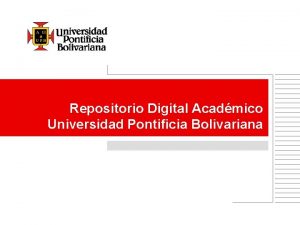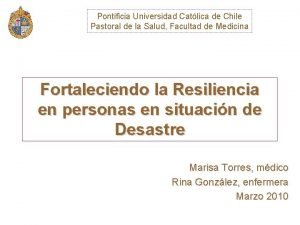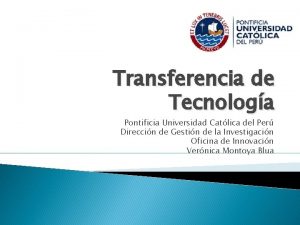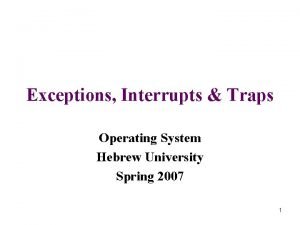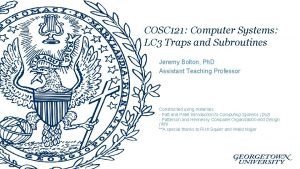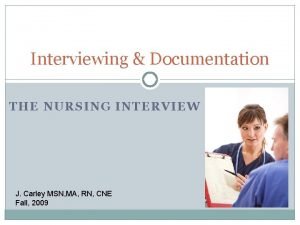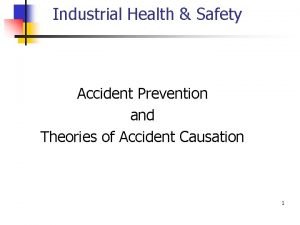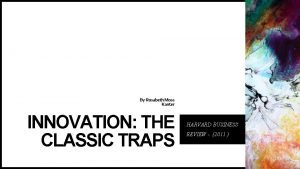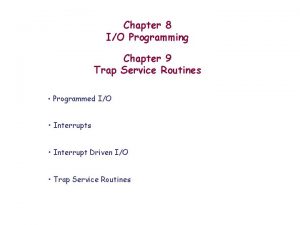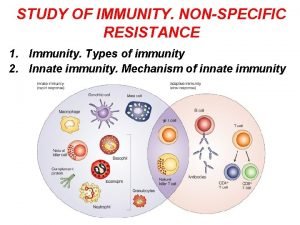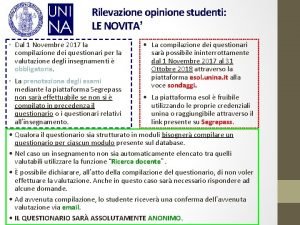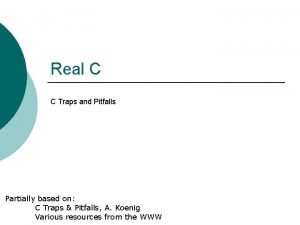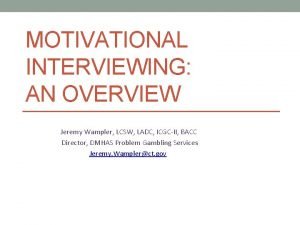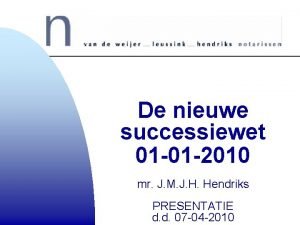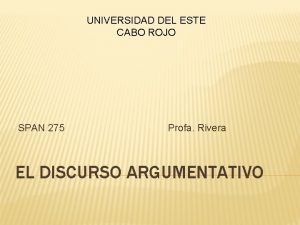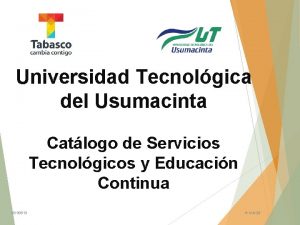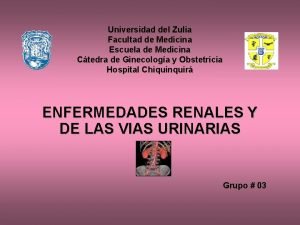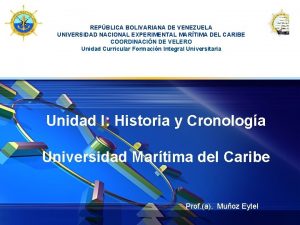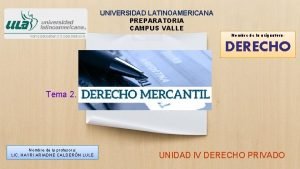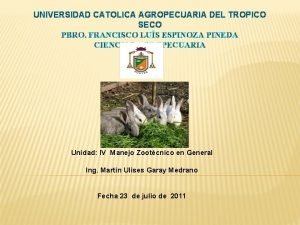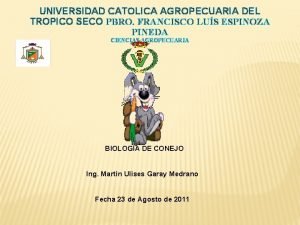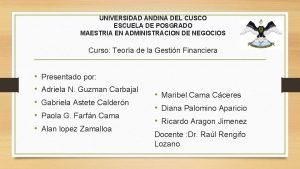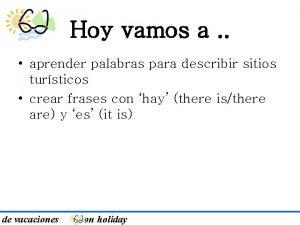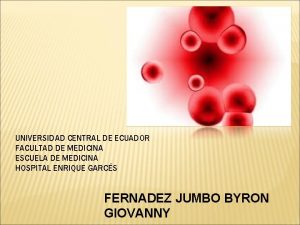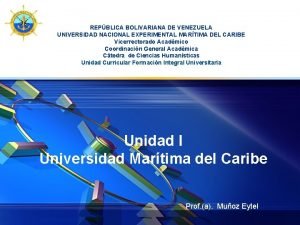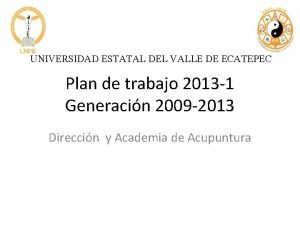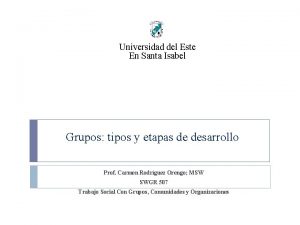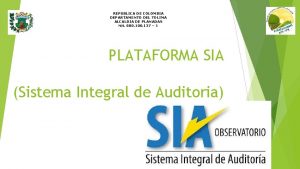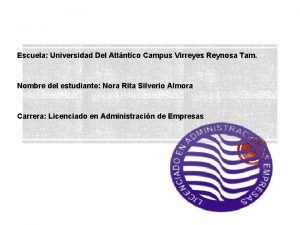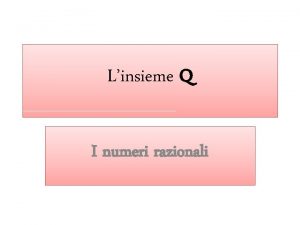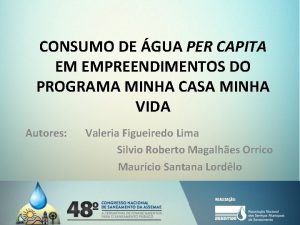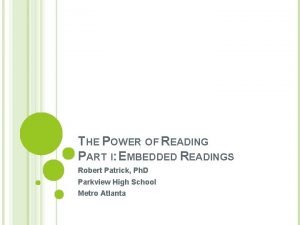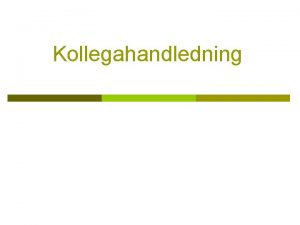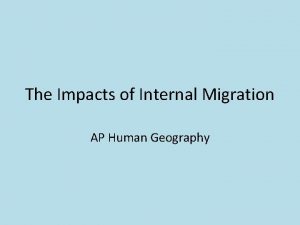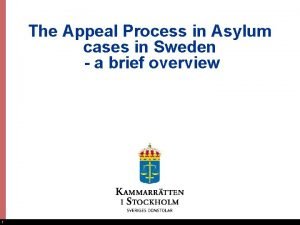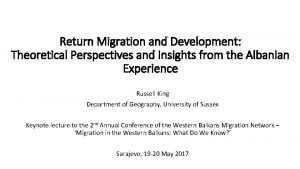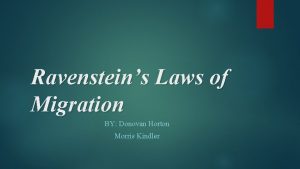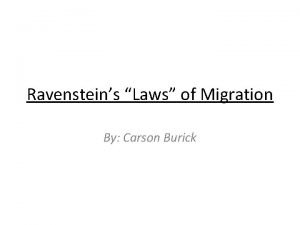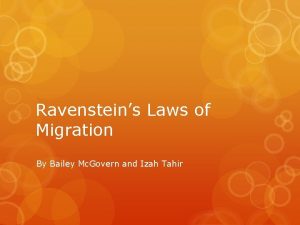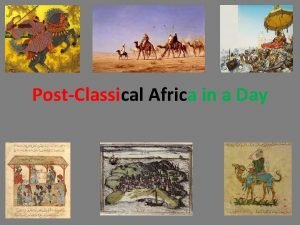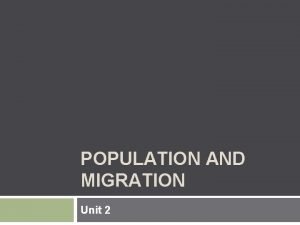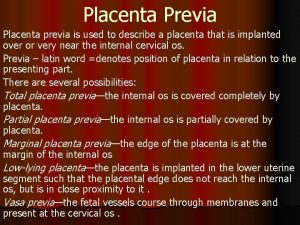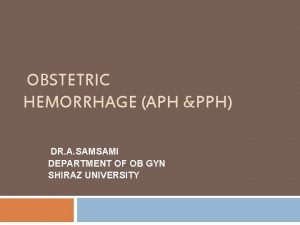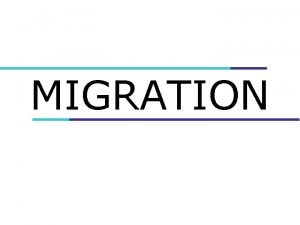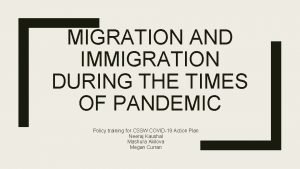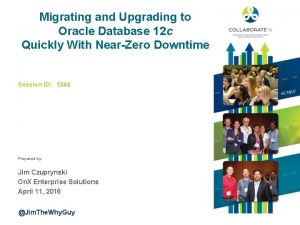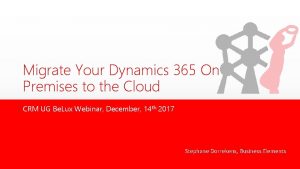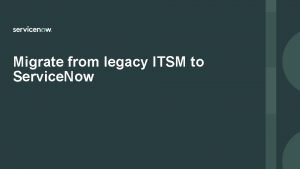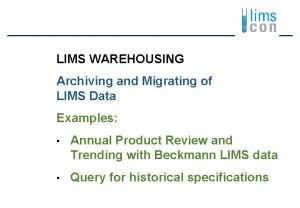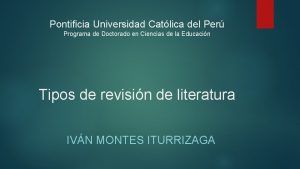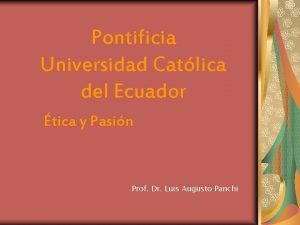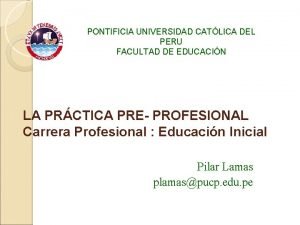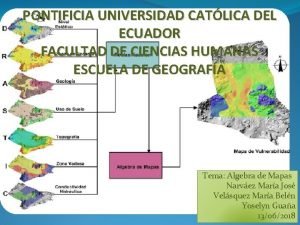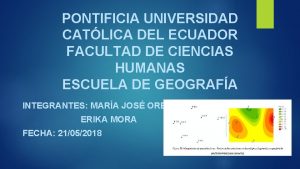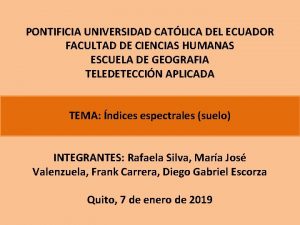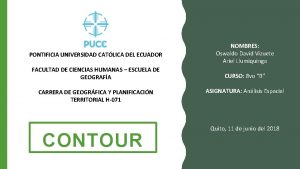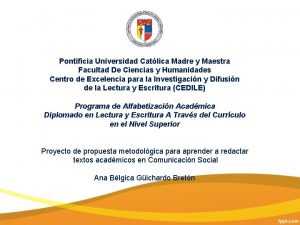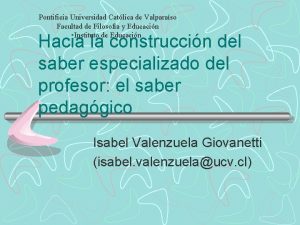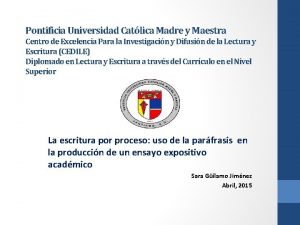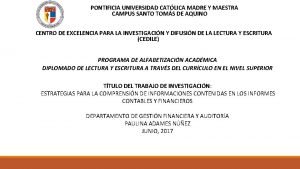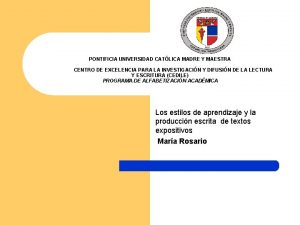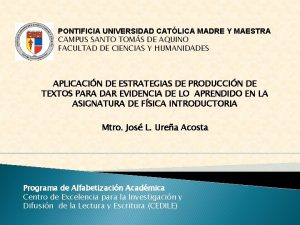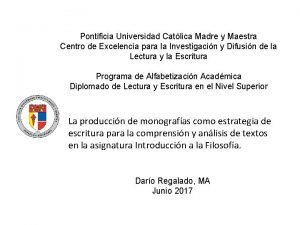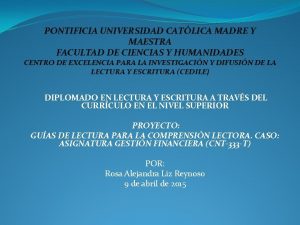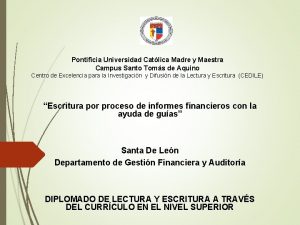Multiple Migration Traps Pontificia Universidad Catlica del Per




































































































- Slides: 100

Multiple Migration Traps Pontificia Universidad Católica del Perú Lima, 2016 Ilhom Abdulloev Rutgers University, Open Society Institute Fellow Gil S. Epstein Bar-Ilan University, CRe. AM and IZA Ira N. Gang Rutgers University, CRe. AM and IZA

Introduction • Migration from poor to rich countries has increased dramatically in recent years. Highlight two important aspects • One: the effect of migration on educational attainments in the migrants’ origin countries. • Two: the level of assimilation of the migrants into the host country via the consumption of ethnic goods. Both are related to each other 2

Aspect 1: Educational attainments in the home country • “Brain Gain” (theoretical and empirical): education has a high return when migrating, and so, the prospect of migrating in the future raises the expected return to education, inducing higher domestic enrollment in schools. Beine, Docquier and Rapoport (2001), Doquier and Rapoport (2009) for a review Cost of migration, Orrenius and Zavodny (2005) 3

Other aspects of education • Migration affects educational outcomes through remittances and not through any other channel such as the incentive effect. Acosta (2006) and López-Córdoba (2005) • Migration of a family member: effects child schooling; parental absence = less parental inputs into education acquisition, and remaining children to undertake housework and short-term labor of children. Mc. Kenzie and Rapoport (2011), Epstein and Kahana (2008), Dimova, Epstein and Gang (2012) Co, Gang and Yun (2000) 4

• Brain Drain: The return to education is higher at destination than at home and thus higher educated emigrate leaving the home country with the low educated individuals. Bhagwati and Hamada (1974) • On the other hand: The return to education is higher in Mexico than for Mexican migrants in the USA as (and) most first-time migration is illegal - job opportunities with low formal educational requirements. This may actually lower the incentive to invest in education. Chiquiar and Hanson (2005) 5

Back-Door Brain Drain • Unskilled migration will increase the return for unskilled workers in the home country: increasing the number of unskilled in the economy. (skilled migration will increase this effect) Stark and Byra (2012) 6

Aspect 2: Migrants in the Host Country Migrants tend to earn wages substantially below those of comparable local workers. Chiswick, 1978; Borjas, 1990 Partly, because of a “lack of effort” of the migrants to assimilate with the local population. 7

The “lack of effort”: desire to maintain a cultural heritage or separate identity, high adjustment costs, such as inadequate language skills, intergenerational familial conflicts and lack of knowledge on the host country labor market. Rivera-Batiz, 1990; Chiswick, 1993; Dustmann, 1993; Licht and Steiner, 1992; Pischke, 1992 and Beenstock, 1993 8

Various indicators are used to measure assimilation The most common: wages and earnings, Other indicators: labor force participation, poverty, and education, more frequently now being looked at over several generations. Ethnosizer: measures the ethnic identify of a migrant rather than his ethnicity. Constant and Zimmermann (2005) and Constant, Gataullina and Zimmermann (2009) 9

The degree of assimilation is influenced by individual factors, the characteristics of the home and host countries, the migration motive, legality of the migrants and the expected migration duration. The greater the similarity between the sending and the receiving countries, i. e. the type of ethnic goods each country consumes, the more rapid is the assimilation. Boeri, Hansen and Mc. Cormick, 2002, Bauer, Lofstroem and Zimmermann, 2000 Venturini, 2004, Kahanec, 2006, Constant, and Zimmermann, 2005, Constant, Gataullina and Zimmermann, 2009 and Isphording and Otten 2012 10

Migrants choose their social traits and consumption of ethnic goods. As the consumption of certain ethnic goods increases, the migrants become more unlike the local population and are less assimilated. Less assimilation affects the reaction of the local population to the migrants and their willingness to accept them. This affects wages and the consumption of ethnic goods 11

One dimension: the choice of religious traits In all religions, individuals have to choose - intensity Islam - praying five times a day, going to Mecca once a year, dress code, not working on Friday, not eating certain specific foods like pork etc. A Greek immigrant to the USA: Will keep all the Greek traditions? Will he talk Greek at home? Sending kids to Sunday Greek school? 12

Who Migrants ? Professional workers Non-Professional workers Consumption of Ethnic goods Wages and Assimilation 13

Traps • Term “trap” evocative – Ensnare, capture unexpectedly – Caught in some sort of bad equilibrium, though made right decisions – Word “trap” suggest there exists a way out • We will identify 5 migration traps 14

The Model 15

Individual’s Utility W(w, s) = w + s Wages wn: Non- Professional Status wp : Professional s=0, Non – professional s >0, Professional 16

Expected discounted lifetime utility V V(n) : Non-Professional V(p) : Professional 17

Professional: Time preference Expected Local wages Expected discounted lifetime utility Migrant's lifetime utility Status Probability of migration 18

• Non – Professional: 19

Outcome and 20

To be come a Professional? Discount lifetime utility of a professional is higher of a non-professional 21

Indifference If wages are higher: choose a profession If wages are lower: do not choose a profession 22

Professional Migration With probability q(p) the individual after becoming a professional worker will emigrate. 1 - q(p) the probability “fail to emigrate” – Brain Gain 23

Emigration from a “developing” country to a developed country Could a doctor immigrate easily from a “developing” country to a developed country? Can a lawyer immigrate easily from a developing country to a developed country? Can an accounted? etc. At high level professions the possibility to immigrate from the developing country to a developed country is very low. 24

To emphasize this, assume that the individual with the professional occupation has a zero probability of immigrating: q(p) = 0 25

Return Migration Discounted lifetime utility of a migrant Migrant's earning in the host country Probability of returning home 26

Brain Loss If the wages of the professional workers are not sufficiently large then individuals will decide not to choose a profession since the chances of migrating and earning a higher discounted utility will be higher not having a profession and thus the market is forcing the individuals not to invest in education. A TRAP ! 27

The Migrant in the Host Country Migrants are assumed to all be of the same origin Two ethnic goods: Isolating ethic goods Non-Isolating ethic goods 28

Isolating Ethnic Goods (h) a. Isolate immigrants from the host population b. Dressing differently, c. Eating different foods, d. Holding onto traditions that interfere with work, type of foods, praying five times a day, etc. Leading to discrimination, harassment, or simply missed work opportunities. Decreases Wages! 29

Non- Isolating Ethnic Goods (R) a. b. c. d. e. f. Donations to schools, Helping the needy, Donations to education centers, Donations to religious institutes (synagogues, mosques) Investment in relations between the home country and the host country, Remittances to family and others in their home country. Do not give rise to income loss 30

Both types of ethnic goods can slow assimilation �They do so at different rates, �Isolating ethnic goods reducing assimilation more than Non-Isolating ethnic goods 31

The Utility of an immigrant in the host country Stone–Geary type function (Basu and Van, 1998) Consumption a >1: the utility from Isolating ethnic goods is higher than the non isolating ethnic goods. 32

Budget Constraint Consumption Ethnic goods Income/wages 33

Income, w, and ethnic goods Isolating Non-Isolating Constant and Zimmermann, (2005) and Constant, Gataullina and Zimmermann, (2009) on ethnicity and earnings. See Chiswick’s (1978, 1991, 1998), Dustman (1997), Mc. Manus, Gould and Welch (1983), Trejo (1997), Berman, Lang and Siniver (2003) and Pendakur (2002) on language proficiency migrants and earnings. Culter and Gleaser (1997) and Borjas (2000) on segregation of minorities and earnings. One way of looking at this is that as one invests more time in consuming ethnic goods he has less time for work 34

If the worker earns a Minimum Wage (w 0) 35

Discounted Lifetime Utility of a Migrant 36

Consumption of Ethnic Goods Optimization If a > 1 higher utility from non Isolating goods 37

• Individuals with higher incomes will invest more in nonisolating ethnic goods (R); • If as income increases the effect of consuming isolating ethnic goods has a stronger affect on wages, the individual will decrease his consumption of such products. 38

Minimum Wage and Ethnic Goods • If a>1 we obtain 39

• Those that arrive in a host country with minimal transferable skills will earn low wages and will invest in the consumption of isolating ethnic goods (decreases probability of assimilation). • Low wage workers will spend more on isolating ethnic goods. This will work to keep them isolated from the native population and in the course of doing so, work to keep their incomes low. - This is a Trap! • As wages increase, the investment in isolating ethnic goods will shrink and investment in ethnic goods that have a smaller negative effect on assimilation will increase. 40

Different Group Sizes (m) • Low income individuals: mh Investing in Isolating ethnic goods • High income individuals: m. R Investing in Non-Isolating ethnic goods 41

Consumption Benefits (mh) • Feeling better about themselves; others may make a better impression on other immigrants, etc. “Belonging” is affected by the size of the population of consumers. • As the “like yours” group size increases, it is easier to consume the ethnic goods and you obtain recognition from your society (for an example, see Berman, 2000). 42

A change in the stock on mh • Increasing the number of low skilled immigrants earning minimum wage will cause those earning wages above minimum wages to increase the consumption of isolating ethnic goods and will decrease assimilation. • Decreasing assimilation will decrease wages. 43

This is a trap ! Bringing in more low wage immigrants will separate not only those new immigrants from the local population but also those that were getting closer to the local population and were on the path towards assimilation 44

Permanent Verse Temporary Migration • Lifespan of the two differs. Permanent: long lifespan, Temporary: Short lifespan 45

Utilities of both groups • Temporary migrant: Permanent migrant: Discounted lifetime utility Probability of increase in income 46

• Permanent migrants will wish to increase R. • Temporary migrants will invest less in R. Increasing temporary migrants will increase the consumption of isolating ethnic goods, forcing the permanent migrants to also increase the consumption of isolating ethnic goods thus decrease their probability of assimilation. Trap! 47

Evidence – Initial Work 48

• The 2007 World Bank Living Standard Survey on Tajikistan. • The survey asks questions on household and individual characteristics, including information on current and returned migrants. • Two rounds: September-October 2007, i. e. during the Ramadan month; the second Round after Ramadan, in October-November 2007. • Including individual working ages of 16 -65. • Sample: 16, 505 people, 1, 535 - migrants (9. 3%) and 14, 970 nonmigrants 49

• Migrants: Individuals who worked abroad and returned to their homes within last 12 months, as well as those who are currently working abroad. 50

Table 2: Probit Regression on Migration Decision (Dependent variable: Migrant==1/0) Variables Years of schooling-squared Estimates Model 1 Model 2 0. 1603 *** (0. 0299) -0. 0069 *** (0. 0013) Education levels: Primary (Grades 1 -4) Basic (Grades 1 -8(9)) Secondary General (Grades 9 -10(11)) Secondary Special and Technical High Other control variables: Age-squared Male No. of children (age of <15) Lives in the capital Lives in other urban areas Own land used for farming Rented land used for farming Own land rented out Constant Observations Pseudo R 2 0. 0943 (0. 0109) -0. 0016 (0. 0002) 1. 3740 (0. 0429) -0. 0633 (0. 0093) -0. 2183 (0. 0499) -0. 1477 (0. 0469) -0. 0005 (0. 0003) -0. 0018 (0. 0007) -0. 0036 (0. 0029) -4. 1221 (0. 2381) 16505 0. 205 *** *** Robust standard errors in parentheses: * p<. 10, ** p<. 05, *** p<. 01 0. 4237 (0. 2247) 0. 5932 (0. 1858) 0. 7762 (0. 1817) 0. 7811 (0. 1859) 0. 5954 (0. 1873) * 0. 0904 (0. 0110) -0. 0015 (0. 0002) 1. 3677 (0. 0431) -0. 0620 (0. 0093) -0. 2117 (0. 0499) -0. 1506 (0. 0468) -0. 0005 (0. 0003) -0. 0017 (0. 0007) -0. 0035 (0. 0029) -3. 8789 (0. 2483) 16505 0. 206 *** Marginal Effects Model 1 Model 2 0. 0003 *** (0. 0010) 0. 0572 (0. 0303) 0. 0800 (0. 0251) 0. 1047 (0. 0245) 0. 1054 (0. 0251) 0. 0803 (0. 0253) *** *** *** -0. 0009 *** (0. 0002) -0. 0010 *** (0. 0002) 0. 1856 (0. 0058) -0. 0085 (0. 0013) -0. 0295 (0. 0067) -0. 0200 (0. 0063) -0. 0001 (0. 0000) -0. 0002 (0. 0001) -0. 0005 (0. 0004) 0. 1845 (0. 0058) -0. 0084 (0. 0013) -0. 0286 (0. 0067) -0. 0203 (0. 0063) -0. 0001 (0. 0000) -0. 0002 (0. 0001) -0. 0005 (0. 0004) *** *** *** *** ** *** 16505 - 51

Years of Schooling at 0 Marginal Effect Model 1 0. 0065 (0. 0009) *** at 4 0. 0095 (0. 0010) *** at 9 0. 0048 (0. 0012) *** at 11 0. 0011 (0. 0011) at 12 0, 015 0, 005 0 0 5 10 15 20 -0, 005 -0. 0008 (0. 0011) -0, 01 at 16 -0. 0075 (0. 0015) *** at 19 -0. 0095 (0. 0010) 16505 *** Observations 0, 01 -0, 015 Standard errors in parentheses: * p<. 10, ** p<. 05, *** p<. 01 52

Table 3: Probit Regression on Migration Decision : Male Subsample (Dependent variable: Migrant==1/0) Variables Years of schooling-squared Estimates Model 1 Model 2 0. 1656 *** (0. 0319) -0. 0076 *** (0. 0014) Education levels: Primary (Grades 1 -4) 0. 3828 (0. 2484) 0. 5697 (0. 1986) 0. 7561 (0. 1934) 0. 7033 (0. 1978) 0. 5056 (0. 1988) Basic (Grades 1 -8(9)) Secondary General (Grades 9 -10(11)) Secondary Special and Technical High Other control variables: Age-squared No. of children (age of <15) Lives in the capital Lives in other urban areas Own land used for farming Rented land used for farming Own land rented out Constant Observations Pseudo R 2 0. 0912 (0. 0112) -0. 0016 (0. 0002) -0. 0531 (0. 0101) -0. 2222 (0. 0545) -0. 2035 (0. 0510) -0. 0005 (0. 0004) -0. 0017 (0. 0007) -0. 0036 (0. 0032) -2. 6774 (0. 2504) 7886 0. 061 *** *** *** Robust standard errors in parentheses: * p<. 10, ** p<. 05, *** p<. 01 0. 0878 (0. 0113) -0. 0015 (0. 0002) -0. 0519 (0. 0101) -0. 2136 (0. 0545) -0. 2047 (0. 0511) -0. 0005 (0. 0004) -0. 0017 (0. 0007) -0. 0036 (0. 0032) -2. 4443 (0. 2574) 7886 0. 062 Marginal Effects Model 1 Model 2 -0. 0019 (0. 0019) 0. 0948 (0. 0615) 0. 1412 (0. 0492) 0. 1874 (0. 0478) 0. 1743 (0. 0489) 0. 1253 (0. 0492) *** *** ** -0. 0019 *** (0. 0004) -0. 0020 *** (0. 0004) -0. 0132 (0. 0025) -0. 0551 (0. 0135) -0. 0505 (0. 0126) -0. 0001 (0. 0001) -0. 0004 (0. 0002) -0. 0009 (0. 0008) -0. 0129 (0. 0025) -0. 0529 (0. 0135) -0. 0507 (0. 0126) -0. 0001 (0. 0001) -0. 0004 (0. 0002) -0. 0009 (0. 0008) *** *** ** *** 7886 - 53

Years of Schooling at 0 at 4 at 9 at 11 Marginal Effects Model 1 0. 0141 (0. 0020) *** 0. 0191 (0. 0022) *** 0. 0074 (0. 0025) *** 0, 025 0, 01 0, 005 0 -0. 0002 (0. 0021) -0, 005 at 12 -0. 0041 (0. 0021) * at 16 -0. 0167 (0. 0027) *** at 19 -0. 0190 (0. 0016) 7886 *** Observations 0, 02 0 5 10 15 20 -0, 015 -0, 025 Standard errors in parentheses: * p<. 10, ** p<. 05, *** p<. 01 54

Table 4. Summary Statistics: Sample with Excluded Heads of Households Variables All Migrant Mean St. Dev. 1 28. 0777 7. 6451 846. 7566 502. 4166 0. 9167 0. 2764 11. 3531 1. 9817 132. 8167 47. 3622 Non-Migrant Mean St. Dev. 0 31. 6507 11. 6951 1138. 5292 863. 4160 0. 3057 0. 4607 10. 4780 2. 8344 117. 8204 51. 4601 Mean 0. 0996 31. 2949 1109. 4752 0. 3666 10. 5651 119. 3137 St. Dev. 0. 2994 11. 4068 839. 0462 0. 4819 2. 7736 51. 2620 Years of schooling of Household's Head 10. 7982 3. 7133 10. 8110 3. 4566 10. 7968 3. 7408 Squared Years of schooling of Household's Head 130. 3892 69. 0480 128. 8175 65. 5378 130. 5630 69. 4259 No. of children (ages of <15)*** 2. 3906 1. 8717 2. 1073 1. 8252 2. 4219 1. 8743 Lives in the capital** Lives in other urban areas** 0. 1245 0. 1448 0. 3301 0. 3519 0. 1073 0. 1249 0. 3096 0. 3307 0. 1264 0. 1470 0. 3323 0. 3541 Land use (sotka): Own land used for farming 18. 1235 49. 5546 17. 0144 37. 5171 18. 2461 50. 7105 Rented land used for farming*** 7. 2327 37. 2336 3. 6269 18. 2497 7. 6315 38. 7462 Own land rented out Observations 0. 0982 3. 5389 0. 0504 0. 6816 0. 1035 3. 7225 Migrant Age*** Age-squared*** Male*** Years of schooling-squared*** Household's characteristics: 12, 543 1, 249 11, 294 Two-sample (migrant and non-migrant) mean-comparison t-tests: * p<. 10, ** p<. 05, *** p<. 01 55

Table 5. IV Probit Regression for Simultaneous Decisions of Migration and Schooling` Structural Eq: Migration=1/0 0. 6704 *** Variables Years of schooling (0. 1385) -0. 0322 *** Years of schooling-squared (0. 0071) 0. 0674 (0. 0188) -0. 0010 (0. 0003) 1. 3595 (0. 1086) -0. 0651 Age-squared Male No. of children (age of <15) *** *** Reduced Form Eq: Years of Schooling Marginal Effects of Structural Eq. -0. 0059 ** (0. 0031) 0. 0510 *** (0. 0004) 0. 0412 *** (0. 0055) -0. 0006 *** (0. 0001) -0. 0492 *** (0. 0174) -0. 0007 0. 0017 *** (0. 0004) 0. 2219 *** (0. 0106) -0. 0106 *** (0. 0112) (0. 0050) (0. 0015) Lives in other urban areas 0. 0690 (0. 0770) -0. 0577 -0. 3027 *** (0. 0291) -0. 1416 *** 0. 0112 (0. 0135) -0. 0094 Own land used for farming (0. 0599) -0. 0007 * (0. 0252) 0. 00002 (0. 0092) -0. 0001 * Rented land used for farming (0. 0004) -0. 0025 *** (0. 0002) -0. 0001 (0. 00006) -0. 0004 *** (0. 0007) (0. 0002) (0. 0001) -0. 0022 (0. 0024) -0. 0005 (0. 0022) 0. 0834 *** -0. 0004 (0. 0004) Lives in the capital Own land rented out Years of schooling of Household's Head -6. 0995 *** (0. 3788) (0. 0096) -0. 0042 *** (0. 0005) 3. 6243 *** (0. 1031) 12, 543 Squared Years of schooling of Household's Head Constant Observations Wald test of exogeneity (/athrho = 0): chi 2(1) = 12, 543 8. 60 Prob > chi 2 = 0. 0034 Standard errors in parentheses: * p<. 10, ** p<. 05, *** p<. 01 56

Years of Schooling at 0 at 4 at 9 at 11 at 12 Marginal Effects Model 1 0. 0001 (0. 0001) 0, 02 0. 0152 (0. 0018) *** 0. 0161 (0. 0042) *** 0, 01 0, 005 0 -0, 005 -0. 0070 (0. 0048) 0 5 10 15 20 -0, 01 -0. 0179 (0. 0080) ** at 16 -0. 0221 (0. 0011) *** at 19 -0. 0019 (0. 0023) 12543 Observations 0, 015 -0, 025 Standard errors in parentheses: * p<. 10, ** p<. 05, *** p<. 01 57

Consumption of Ethnic Goods The assimilation of Central Asians into the Muscovite Economy 58

• Migration in the Former Soviet areas can be divided into two main phases. a. Migration at the time of the Soviet breakup (an ethnic migration that went on for a few years). b. Economic migration starting in the later 1990 s that reflects large income differentials among the countries. 59

Big differences in the GDP per capita: • Top five countries which have higher per capita GDP rates are: Estonia (US$16, 533), Lithuania (US$13, 339), Russian Federation (US$13, 089), Latvia (US$12, 726), and Kazakhstan (US$11, 357). • The lowest five countries are: Tajikistan (US$935), Kyrgyzstan (US$1, 075), Uzbekistan (US$1, 546), Moldova (US$1, 967), and Georgia (US$3, 202). (2011 Data. World Bank, 2013) 60

• Increasing income inequality among these countries along with free entry travel policies drives many people from the lower income countries to the richer countries. • The top five countries with high GDP per capita receive 63% of migrants from countries of former USSR • The Russian Federation is the main recipient of migrants in the region: migrants from former USSR countries make up 96% of all its foreign immigrants, and 59% of all migrants in this region. 61

• We use data collected by the Independent Research Service SREDA in an effort to take a snapshot of marginalized migrant groups in Moscow. • Information was collected from 401 (173) migrants from mainly Central Asian states who were queued in two Federal Migration Service offices in Moscow in July 2012. 62

Map of the Commonwealth of Independent States http: //www. socsci. uci. edu/~pgarb/istudies/Eurasia/eurasia_fall 11/maps/cispink 6. gif 63

The survey questions include information about: migrant characteristics, their major problems in Russia, perception of Russians, migrants' integration capacity, attitude towards religion, knowledge of Russian language, Interest on attending courses on Russian language, culture…… 64

O. L. S. Results – Log Earnings Dependent variable: log(earnings) Male Age-squared Secondary education or lower More than 6 months less than a year More than one and less than two years More than two and less than five years More than five years My family is in Moscow Communication with compatriots every day Want a citizenship Mosque Attendance Want children to be like Russians Internet user Plan to stay several years Plan to stay forever Send Remittances Want to attend Russian language courses Speaks Russian fluently Constant Observations R 2 All 0. 3133 (0. 1009) 0. 0164 (0. 0262) -0. 0001 (0. 0004) -0. 1430 (0. 0751) 0. 1521 (0. 0854) 0. 0803 (0. 0906) 0. 0602 (0. 1041) 0. 0657 (0. 0824) 0. 3195 (0. 1216) -0. 1477 (0. 0577) 0. 1564 (0. 0859) 0. 0760 (0. 0796) -0. 1969 (0. 0787) 0. 1381 (0. 0592) 0. 0519 (0. 0648) 0. 0623 (0. 0764) 0. 3741 (0. 0884) -0. 1085 (0. 0567) 0. 1571 (0. 0881) 8. 9690 (0. 5144) 173 0. 272 *** * ** ** * * *** 65

Probit: Dependent variable Independent variables Male Communication with Compatriots every day Age-squared Secondary Education or lower More than 6 months less than a year More than one and less than two years More than two and less than five years More than five years My family is in Moscow Want a citizenship Want children to be like Russians Internet user Plan to stay several years Plan to stay forever Send Remittances Want to attend Russian language courses Speaks Russian fluently logwage Mosque Attendance Constant Observations Pseudo R 2 Mosque Attendance Probit 0. 9575 ** (0. 4701) 1. 1195 ** (0. 4628) 0. 0583 (0. 1120) -0. 0013 (0. 0016) 0. 8855 *** (0. 3433) 0. 7099 * (0. 3770) 1. 0515 ** (0. 4097) 0. 7843 ** (0. 3868) 1. 1454 *** (0. 3674) 1. 8860 *** (0. 6488) -0. 1624 (0. 3821) -0. 3455 (0. 3745) 0. 3882 (0. 2829) 0. 0991 (0. 2681) 0. 2306 (0. 3858) 1. 5092 *** (0. 5840) 0. 1666 (0. 2837) -1. 3972 *** (0. 3158) 0. 3970 (0. 2669) -9. 0946 *** (3. 2385) 173 0. 317 66

Probit: Dependent variable Independent variables Communicate w. Compatriots Male - Communication with Compatriots every day Age - Age-squared Secondary Education or lower More than 6 months less than a year More than one and less than two years More than two and less than five years More than five years My family is in Moscow Want a citizenship Want children to be like Russians Internet user Plan to stay several years Plan to stay forever Send Remittances Want to attend Russian language courses Speaks Russian fluently logwage Mosque Attendance Constant Observations Pseudo R 2 0. 3666 *** (0. 1402) -0. 0042 ** (0. 0019) -0. 1949 (0. 4371) -0. 4228 (0. 5472) -0. 0298 (0. 6031) 0. 6506 (0. 6769) -0. 4338 (0. 5629) -0. 2282 (0. 6590) -0. 4363 (0. 4630) -0. 2476 (0. 4247) 0. 7699 (0. 4228) 0. 6267 (0. 4412) 0. 1128 * (0. 4956) -0. 1559 (0. 7377) -0. 0953 (0. 3364) -0. 4807 (0. 3669) -0. 9025 *** (0. 3070) 0. 6272 (0. 4003) 3. 8386 (3. 7823) 173 0. 262 67

Probit: Dependent variable Independent variables Remit Male 0. 2156 (0. 5931) 0. 1883 (0. 8654) -0. 8758 (0. 3177) 0. 0152 (0. 0052) -0. 4631 (0. 5475) 0. 2415 (0. 9730) 1. 5979 (0. 9726) 1. 1685 (0. 9481) 0. 4538 (0. 7956) -4. 3376 (0. 9703) 4. 2370 Communication with Compatriots every day Age-squared Secondary Education or lower More than 6 months less than a year More than one and less than two years More than two and less than five years More than five years My family is in Moscow Want a citizenship (1. 2947) -5. 8215 (1. 6596) -2. 6187 (0. 7961) -1. 4379 (0. 7511) -1. 5326 Want children to be like Russians Internet user Plan to stay several years Plan to stay forever *** *** *** * * (0. 7845) Send Remittances Want to attend Russian language courses 0. 0597 (0. 4647) 0. 2781 Speaks Russian fluently (0. 5054) 3. 0427 (0. 7955) 2. 1380 logwage Mosque Attendance Constant Observations Pseudo R 2 0. 317 0. 262 (0. 6744) -12. 9983 (6. 4493) 173 0. 672 *** ** 68 0. 448 0. 175 0. 687 0. 643

Probit: Dependent variable Independent variables Children be like Russians Male Want a citizenship 1. 2376 (0. 7753) -0. 3755 (0. 6284) 0. 0093 (0. 1893) 0. 0015 (0. 0027) -0. 2704 (0. 6253) 0. 9466 (0. 6396) 1. 3620 ** (0. 5977) 0. 8987 (0. 6584) 0. 5648 (0. 6736) 1. 8239 *** (0. 6671) 4. 3959 *** Want children to be like Russians (0. 5628) - Communication with Compatriots every day Age-squared Secondary Education or lower More than 6 months less than a year More than one and less than two years More than two and less than five years More than five years My family is in Moscow Internet user Plan to stay several years Plan to stay forever Send Remittances Want to attend Russian language courses Speaks Russian fluently logwage Mosque Attendance Constant Observations Pseudo R 2 1. 1953 *** (0. 3897) -0. 2644 (0. 4190) -0. 3540 (0. 4641) -1. 4996 *** (0. 5139) -0. 4398 (0. 4463) -0. 0132 (0. 5264) -1. 5011 *** (0. 4977) -0. 5726 (0. 3868) 9. 7569 (5. 9849) 173 0. 687 69

Concluding Remarks Considered the relationship between who migrates, education and the consumption of ethnic goods, wages and assimilation. Incentive for low educated individuals to migrate Potential migrants invest less in education (Trap 1) Low educated migrants consume more ethnic goods 70

The consumption of ethnic goods makes the migrants differ from the local population and as a result affects assimilation and wages Less assimilation affects the reaction of the local population towards them and their willingness to accept the migrants (Trap 2). 71

As income decreases migrants tend to consume more isolating ethnic goods and decreases the probability of assimilation in the future (Trap 3). PBringing in more low wage immigrants will separate not only those new immigrants from the local population but also those that were getting closer to the local population and were on the path towards assimilation (Trap 4) PIncreasing temporary migration will increase the consumption of isolating ethnic goods, forcing the permanent migrants to also increase the consumption of isolating ethnic goods thus decrease their probability of assimilation (Trap 5) 72

Thank you!!! 73

Table 1. Sample Statistics Variables All Migrant Mean St. Dev. 1 30. 7746 9. 4105 1035. 5746 656. 2917 0. 9296 0. 2558 11. 4078 2. 0510 134. 3420 48. 1560 Non-Migrant Mean St. Dev. 0 35. 3470 12. 9622 1417. 4194 1000. 1301 0. 4315 0. 4953 10. 8063 2. 9243 125. 3265 56. 5498 Mean 0. 0930 34. 9218 1381. 9071 0. 4778 10. 8622 126. 1650 St. Dev. 0. 2904 12. 7431 979. 5725 0. 4995 2. 8596 55. 8825 Education levels: Primary (Grades 1 -4)*** Basic (Grades 1 -8(9))*** Secondary General (Grades 9 -10(11))*** Secondary Special and Technical*** High 0. 0340 0. 1708 0. 5260 0. 1318 0. 1135 0. 1812 0. 3763 0. 4993 0. 3383 0. 3172 0. 0098 0. 1036 0. 6091 0. 1609 0. 1121 0. 0984 0. 3048 0. 4881 0. 3676 0. 3155 0. 0365 0. 1777 0. 5174 0. 1289 0. 1136 0. 1875 0. 3823 0. 4997 0. 3351 0. 3174 Household's characteristics: No. of children (ages of <15)*** Lives in the capital*** Lives in other urban areas** 2. 3267 0. 1417 0. 1510 1. 8203 0. 3487 0. 3580 2. 1622 0. 1094 0. 1277 1. 7782 0. 3123 0. 3339 2. 3436 0. 1450 0. 1534 1. 8238 0. 3521 0. 3604 17. 0450 6. 7229 0. 1061 48. 0383 35. 8806 3. 7025 16. 3205 4. 0762 0. 0495 35. 5967 23. 1511 0. 6871 17. 1192 6. 9943 0. 1120 49. 1367 36. 9286 3. 8814 Migrant Age*** Age-squared*** Male*** Years of schooling-squared*** Land use (sotka): Own land used for farming Rented land used for farming*** Own land rented out* Observations 16505 1535 Two-sample (migrant and non-migrant) mean-comparison t-tests: * p<. 10, ** p<. 05, *** p<. 01 14970 74

Former Soviet Countries’ GDP Per Capita Rates, 1990 -2011 Source: World Bank. World Development Indicators. 75

Net Migration in Former Soviet Countries, 1960 -2010 Source: World Bank. World Development Indicators. 76

Russian Federation • • • Major net migrant recipient among former Soviet countries. Main destination country for Central Asian Migrants. GDP (current, 2010): US$1, 857, 769, 676, 144 Population (2010): 141, 930, 000 GDP per capita (current, 2010): US$10, 481 Annual GDP growth (2010): 4% Unemployment, % of total labor force (2010): 8% Trade (% of GDP, 2010): 52% Land area (2010): 16, 376, 870 sq. km Language: Russian 77

Kyrgyzstan • • • GDP (current, 2010): US$4, 794, 361, 821 Population (2010): 5, 447, 900 GDP per capita (current, 2010): US$880 Annual GDP growth (2010): 0% Unemployment, % of total labor force (2010): 9% Trade (% of GDP, 2010): 133% Land area (2010): 191, 800 sq. km Language: Kyrgyz (related to Turkish languages) Major Religion: Islam 78

Tajikistan • • • World’s most remittance-dependent country. GDP (current, 2010): US$5, 641, 741, 963 Population (2010): 6, 878, 637 GDP per capita (current, 2010): US$820 Annual GDP growth (2010): 7% Trade (% of GDP, 2010): 76% Land area (2010): 139, 960 sq. km Language: Tajik (Persian language) Major Religion: Islam Civil war: 1992 -1997 79

Uzbekistan • • GDP (current, 2010): US$39, 332, 771, 014 Population (2010): 28, 562, 400 GDP per capita (current, 2010): US$1, 377 Annual GDP growth (2010): 9% Trade (% of GDP, 2010): 62% Land area (2010): 425, 400 sq. km Language: Uzbek (Turkic Language) Major Religion: Islam 80

Variables logwage Male Age-squared Mosque Attendance Detailed Description Logarithms of last month earnings, a continuous variable: 8. 0064 -12. 4292 Dummy variable taking a value of 1 if the respondent is man. Age of the respondent, a continuous variable, 19 -57 Squared age of the respondent, a continuous variable, 361 -3249 Dummy variable taking a value of 1 if the respondent has education from vocational schools or lower. Dummy variable taking a value of 1 if the respondent has been in Moscow for 6 months but less than a year. Dummy variable taking a value of 1 if the respondent has been in Moscow for more than 1 year but less than 2 years. Dummy variable taking a value of 1 if the respondent has been in Moscow for more than 2 years but less than 5 years. Dummy variable taking a value of 1 if the respondent has been in Moscow for more than 5 years. Dummy variable taking a value of 1 if the respondent's family is in Moscow. Dummy variable taking a value of 1 if the respondent communicates daily with his compatriots. Dummy variable taking a value of 1 if the respondent communicates wants to become Russian citizen. Dummy variable taking a value of 1 if the respondent attended Mosque in Moscow. Want children to be like Russians Dummy variable taking a value of 1 if the respondent wants children be like Russians. Internet user Dummy variable taking a value of 1 if the respondent uses the internet. Dummy variable taking a value of 1 if the respondent plans to stay for several years. Secondary Education or lower More than 6 months less than a year More than one and less than two years More than two and less than five years More than five years My family is in Moscow Communication with Compatriots every day Want a citizenship Plan to stay several years Plan to stay forever Send Remittances Dummy variable taking a value of 1 if the respondent plans to stay forever. Dummy variable taking a value of 1 if the respondent sends money to his home country. Want to attend Russian language courses Dummy variable taking a value of 1 if the respondent wants to attend Russian courses. Speaks Russian fluently Dummy variable taking a value of 1 if the respondent speaks fluently Russian, which 81 is evaluated by an interviewer.

Correlations with Earnings Variable Values Correlation with logwage 8. 0064 -12. 4292 1 Male 0, 1 0. 143 0. 0611 Age 19 -57 0. 0869 0. 2555 361 -3249 0. 088 0. 2496 Secondary Education or lower 0, 1 -0. 188* 0. 0133 More than 6 months less than a year 0, 1 0. 0553 0. 4698 More than one and less than two years 0, 1 0. 0406 0. 5958 More than two and less than five years 0, 1 -0. 0312 0. 6841 More than five years 0, 1 0. 0961 0. 2085 My family is in Moscow 0, 1 0. 139 0. 0684 Communication with Compatriots every day 0, 1 -0. 107 0. 1603 Want a citizenship 0, 1 0. 0495 0. 5175 Mosque Attendance 0, 1 0. 0356 0. 6415 Want children to be like Russians 0, 1 -0. 00837 0. 913 Internet user 0, 1 0. 178* 0. 0193 Plan to stay several years 0, 1 0. 0694 0. 3639 Plan to stay forever 0, 1 0. 0932 0. 2228 Send Remittances 0, 1 0. 112 0. 1413 Want to attend Russian language courses 0, 1 -0. 176* 0. 0206 Speaks Russian fluently 0, 1 0. 258*** 0. 0006 Age-squared * p < 0. 05, ** p < 0. 01, *** p < 0. 001 Significance level 82

Sample Statistics logwage Male Age-squared Secondary Education or lower All mean sd 10. 01 0. 42 0. 92 0. 26 31. 47 8. 63 1064. 66 603. 18 0. 82 0. 39 Central Asia mean sd 9. 95 0. 43 0. 92 0. 27 31. 09 8. 40 1036. 41 581. 91 0. 87 0. 34 Kyrgyzstan mean sd 9. 94 0. 32 0. 82 0. 39 28. 38 7. 72 863. 77 496. 70 0. 87 0. 34 Tajikistan mean sd 9. 96 0. 35 0. 92 0. 27 31. 92 8. 18 1084. 13 591. 24 0. 87 0. 34 Uzbekistan mean sd 9. 96 0. 53 0. 98 0. 13 32. 30 8. 68 1117. 05 611. 50 0. 87 0. 34 More than 6 months less than a year More than one and less than two years 0. 12 0. 17 0. 33 0. 37 0. 13 0. 17 0. 34 0. 38 0. 23 0. 43 0. 08 0. 11 0. 27 0. 31 0. 10 0. 18 0. 30 0. 39 More than two and less than five years 0. 20 0. 40 0. 13 0. 34 0. 24 0. 43 0. 23 0. 42 More than five years My family is in Moscow 0. 33 0. 07 0. 47 0. 25 0. 29 0. 06 0. 46 0. 23 0. 15 0. 08 0. 37 0. 27 0. 37 0. 05 0. 49 0. 23 0. 33 0. 05 0. 47 0. 22 Communication with Compatriots every day Want a citizenship Mosque Attendance Want children to be like Russians Internet user Plan to stay several years Plan to stay forever Send Remittances Want to attend Russian language courses Speaks Russian fluently 0. 92 0. 49 0. 47 0. 62 0. 55 0. 47 0. 18 0. 90 0. 38 0. 43 0. 26 0. 50 0. 49 0. 50 0. 39 0. 30 0. 49 0. 50 0. 93 0. 43 0. 58 0. 70 0. 51 0. 47 0. 14 0. 91 0. 44 0. 34 0. 25 0. 50 0. 46 0. 50 0. 35 0. 28 0. 50 0. 48 0. 92 0. 46 0. 56 0. 67 0. 54 0. 56 0. 13 0. 85 0. 44 0. 54 0. 27 0. 51 0. 50 0. 48 0. 51 0. 50 0. 34 0. 37 0. 50 0. 51 0. 92 0. 53 0. 68 0. 66 0. 50 0. 39 0. 11 0. 97 0. 47 0. 34 0. 27 0. 51 0. 47 0. 48 0. 51 0. 50 0. 31 0. 16 0. 51 0. 48 0. 95 0. 34 0. 52 0. 75 0. 51 0. 46 0. 16 0. 92 0. 43 0. 21 0. 22 0. 48 0. 50 0. 43 0. 50 0. 37 0. 28 0. 50 0. 41 Observations 173 138 39 38 61 83

Migrant Assimilation Survey Data • Data from the Independent Research Service SREDA • 401 migrants queued in two Federal Migration Service offices in Moscow in July 2012. • Excluded citizens of Baltic and Slavic states. • Interviewees were randomly sampled with respect to their citizenship. Citizenship 5% 2% 1% 7% Uzbekistan 38% Tajikistan Kyrgyzstan Moldova 23% Armenia Azerbadjan Turkmenistan 24% 84

Who are the Migrants? Age Gender 10% 18 -24 Education 29% 25 - 34 Lower Secondary 41% 19% 45 -54 Icomplete High Education Male 2% 10% High Education 90% 79% Secondary Special 35 -44 55 -64 7% 13% 1% Female 85

How Long and Why Goal of the visit How long have you been in Moscow? < 6 months >5 years 1% 31% ≥ 6 months and <2 years 2 -5 years 2% 23% 18% 28% 97% To earn money To study Others 86

Earnings and Remittances Do you send money to your home country? Your earnings for last month ≤ 15 000 5% 15 001 - 20 000 20 001 - 25 000 19% 25 001 - 30 000 > 30 000 Did not answer 21% 25% 15% 73% 7% 18% Yes No Did not answer 87

Assimilation Would you like your children become like the Russians? Family 5% 5% 20% 30% 75% In the home country Some in Moscow, others in the home country in Moscow 64% Yes No Did not answer 88

Assimilation Communication with compatriots 7% 0% 2% Plans to Remain in Russia less than 1 year Willingness to Receive the Russian Citizenship 9% 34% for several years 45% 38% Forever 14% Did not answer 14% 91% Daily Once in few days Not evry month Did not answer 46% Yes No Did not answer 89

Assimilation Assessment of Respondent’s Knowledge of Russian Language by Interviewer 6% Willingness to Attend Free Language Courses 4% 34% 40% 14% 48% 45% Fluent 8% Yes In between No Did not answer Understands everything but speaks with an accent and some mistakes Mostly understands, but has difficulties in expressing thoughts Speaks with difficulties 90

Assimilation 1% 1% 1% Faith in God Religion 2% Mosque Attendence 33% 13% 24% 18% 12% 85% 97% Believe In between Do not believe Did not answer Christians Muslims Did not answer Regularly 13% Have not Do not been, but want several like to times Did not answer 91

Willingness to Receive the Russian Citizenship (%) Citizens of Uzbekistan Citizens of Tajikistan Citizens of Kyrgyzstan 7 11 9 29 42 39 54 49 61 Yes No Did not answer 92

Would you like your children to become like the Russians? (%) Citizens of Uzbekistan 1 Citizens of Tajikistan Citizens of Kyrgyzstan 9 8 19 26 32 80 60 Yes 65 No Did not answer 93

Mosque Attendance Citizens of Uzbekistan Regularly 8% Have been several times Do now want Did not answer Regularly 32% Have not been, but like to Citizens of Tajikistan 23% 14% 33% Have not been, but like to Did not answer Regularly 9% 36% Have been several times Do not want 23% 21% Citizens of Kyrgyzstan 20% 16% Have been several times Have not been, but like to Do not want Did not answer 29% 14% 12% 94

Assessment of Respondent’s Knowledge of Russian Language by Interviewer Citizens of Uzbekistan Citizens of Tajikistan 9% Citizens of Kyrgyzstan 7% 24% 16% 29% 12% 3% 21% 50% 37% 43% 47% Fluent Understands everything but speaks with an accent and some mistakes Mostly understands, but has difficulties in expressing thoughts Speaks with difficulties 95

Willingness to Attend Russian Language Courses (%) Citizens of Uzbekistan Citizens of Tajikistan Citizens of Kyrgyzstan 8 1 2 36 38 44 55 53 7 42 8 Yes In between No Did not answer 7 96

Ordinary Least Squares Regression Results Dependent variable: log(earnings) Male Age-squared Secondary education or lower More than 6 months less than a year More than one and less than two years More than two and less than five years More than five years My family is in Moscow Communication with compatriots every day Want a citizenship Mosque Attendance Want children to be like Russians Internet user Plan to stay several years Plan to stay forever Send Remittances Want to attend Russian language courses Speaks Russian fluently Constant Observations R 2 All 0. 3133 (0. 1009) 0. 0164 (0. 0262) -0. 0001 (0. 0004) -0. 1430 (0. 0751) 0. 1521 (0. 0854) 0. 0803 (0. 0906) 0. 0602 (0. 1041) 0. 0657 (0. 0824) 0. 3195 (0. 1216) -0. 1477 (0. 0577) 0. 1564 (0. 0859) 0. 0760 (0. 0796) -0. 1969 (0. 0787) 0. 1381 (0. 0592) 0. 0519 (0. 0648) 0. 0623 (0. 0764) 0. 3741 (0. 0884) -0. 1085 (0. 0567) 0. 1571 (0. 0881) 8. 9690 (0. 5144) 173 0. 272 *** * ** ** * * *** Central Asia 0. 2125 (0. 1148) 0. 0321 (0. 0281) -0. 0003 (0. 0004) -0. 0482 (0. 1048) 0. 1858 (0. 0872) 0. 1002 (0. 0935) 0. 0707 (0. 1142) 0. 0524 (0. 0856) 0. 3516 (0. 1489) -0. 2213 (0. 0903) 0. 1664 (0. 0948) 0. 1376 (0. 0880) -0. 2067 (0. 0823) 0. 1429 (0. 0703) 0. 0784 (0. 0685) 0. 0944 (0. 0921) 0. 4170 (0. 0935) -0. 0807 (0. 0637) 0. 1583 (0. 0976) 8. 6229 (0. 5809) 138 0. 281 = * Kyrgyzstan + Tajikistan + Uzbekistan ** *** 97

O. L. S Regression Results Dependent variable: log(earnings) Male Age-squared Secondary education or lower More than 6 months less than a year More than one and less than two years More than two and less than five years More than five years My family is in Moscow Communication with compatriots every day Want a citizenship Mosque Attendance Want children to be like Russians Internet user Plan to stay several years Plan to stay forever Send Remittances Want to attend Russian language courses Speaks Russian fluently Constant Observations R 2 All 0. 3133 (0. 1009) 0. 0164 (0. 0262) -0. 0001 (0. 0004) -0. 1430 (0. 0751) 0. 1521 (0. 0854) 0. 0803 (0. 0906) 0. 0602 (0. 1041) 0. 0657 (0. 0824) 0. 3195 (0. 1216) -0. 1477 (0. 0577) 0. 1564 (0. 0859) 0. 0760 (0. 0796) -0. 1969 (0. 0787) 0. 1381 (0. 0592) 0. 0519 (0. 0648) 0. 0623 (0. 0764) 0. 3741 (0. 0884) -0. 1085 (0. 0567) 0. 1571 (0. 0881) 8. 9690 (0. 5144) 173 0. 272 *** * ** ** * * *** Central Asia 0. 2125 (0. 1148) 0. 0321 (0. 0281) -0. 0003 (0. 0004) -0. 0482 (0. 1048) 0. 1858 (0. 0872) 0. 1002 (0. 0935) 0. 0707 (0. 1142) 0. 0524 (0. 0856) 0. 3516 (0. 1489) -0. 2213 (0. 0903) 0. 1664 (0. 0948) 0. 1376 (0. 0880) -0. 2067 (0. 0823) 0. 1429 (0. 0703) 0. 0784 (0. 0685) 0. 0944 (0. 0921) 0. 4170 (0. 0935) -0. 0807 (0. 0637) 0. 1583 (0. 0976) 8. 6229 (0. 5809) 138 0. 281 * ** ** *** *** Kyrgyzstan 0. 3118 (0. 2842) -0. 0283 (0. 0635) 0. 0003 (0. 0010) -0. 1388 (0. 2050) 0. 2510 (0. 1961) 0. 1802 (0. 1646) 0. 3047 (0. 2092) 0. 4324 (0. 2580) 0. 0674 (0. 3167) -0. 3082 (0. 2292) -0. 0378 (0. 1659) 0. 1586 (0. 2551) 0. 0858 (0. 2198) -0. 1504 (0. 1813) -0. 1172 (0. 1545) 0. 0049 (0. 2200) 0. 2692 (0. 1944) -0. 1076 (0. 1699) 0. 1682 (0. 2867) 10. 1923 *** (1. 1605) 39 0. 526 Tajikistan 0. 1993 (0. 2485) 0. 0794 (0. 0496) -0. 0010 (0. 0007) -0. 0992 (0. 2108) 0. 3487 (0. 2090) -0. 0788 (0. 2175) 0. 1934 (0. 1773) 0. 1894 (0. 1435) -0. 5807 (0. 3773) -0. 6128 (0. 2151) 0. 5250 (0. 2041) -0. 0127 (0. 1338) -0. 4777 (0. 1745) 0. 0423 (0. 1314) 0. 2496 (0. 1672) 0. 4300 (0. 2762) -0. 1748 (0. 2736) -0. 3648 (0. 1659) 0. 0527 (0. 1612) 8. 9050 (1. 0361) 38 0. 699 ** ** *** Uzbekistan 0. 5754 (0. 4645) 0. 0603 (0. 0562) -0. 0005 (0. 0007) -0. 0458 (0. 2037) 0. 0686 (0. 1927) 0. 2355 (0. 1763) -0. 0076 (0. 2632) -0. 1377 (0. 2174) 0. 7043 (0. 2123) -0. 3163 (0. 1938) 0. 1816 (0. 2446) 0. 1703 (0. 1810) -0. 2422 (0. 2445) 0. 2641 (0. 1338) 0. 1068 (0. 1571) 0. 0565 (0. 3365) 0. 4921 (0. 2107) -0. 0444 (0. 1315) 0. 4891 (0. 3695) 7. 4996 (1. 3018) 61 0. 378 *** *** 98

Probit: Dependent variable Independent variables Male Communication with Compatriots every day Age-squared Secondary Education or lower More than 6 months less than a year More than one and less than two years More than two and less than five years More than five years My family is in Moscow Want a citizenship Want children to be like Russians Internet user Plan to stay several years Plan to stay forever Send Remittances Want to attend Russian language courses Speaks Russian fluently logwage Mosque Attendance Constant Observations Pseudo R 2 Mosque Attendance Communicate w. Compatriots - Remit 0. 9575 ** (0. 4701) 1. 1195 ** (0. 4628) 0. 0583 (0. 1120) -0. 0013 (0. 0016) 0. 8855 *** (0. 3433) 0. 7099 * (0. 3770) 1. 0515 ** (0. 4097) 0. 7843 ** (0. 3868) 1. 1454 *** (0. 3674) 1. 8860 *** (0. 6488) -0. 1624 0. 3666 *** (0. 1402) -0. 0042 ** (0. 0019) -0. 1949 (0. 4371) -0. 4228 (0. 5472) -0. 0298 (0. 6031) 0. 6506 (0. 6769) -0. 4338 (0. 5629) -0. 2282 (0. 6590) -0. 4363 0. 2156 (0. 5931) 0. 1883 (0. 8654) -0. 8758 (0. 3177) 0. 0152 (0. 0052) -0. 4631 (0. 5475) 0. 2415 (0. 9730) 1. 5979 (0. 9726) 1. 1685 (0. 9481) 0. 4538 (0. 7956) -4. 3376 (0. 9703) 4. 2370 (0. 3821) -0. 3455 (0. 3745) 0. 3882 (0. 2829) 0. 0991 (0. 2681) 0. 2306 (0. 4630) -0. 2476 (0. 4247) 0. 7699 (0. 4228) 0. 6267 (0. 4412) 0. 1128 (1. 2947) -5. 8215 (1. 6596) -2. 6187 (0. 7961) -1. 4379 (0. 7511) -1. 5326 (0. 3858) 1. 5092 *** (0. 5840) 0. 1666 (0. 2837) -1. 3972 *** (0. 4956) -0. 1559 (0. 7377) -0. 0953 (0. 3364) -0. 4807 (0. 7845) (0. 3158) 0. 3970 (0. 2669) - (0. 3669) -0. 9025 *** (0. 3070) 0. 6272 (0. 5054) 3. 0427 (0. 7955) 2. 1380 -9. 0946 *** (3. 2385) 173 0. 317 (0. 4003) 3. 8386 (3. 7823) 173 0. 262 (0. 6744) -12. 9983 (6. 4493) 173 0. 672 - * Speaks Rus. Fluently *** *** *** * * -1. 1176 (0. 5372) -0. 4870 (0. 6300) 0. 0981 (0. 1195) -0. 0012 (0. 0017) -0. 8066 (0. 3500) 0. 0541 (0. 4551) 0. 2466 (0. 4374) 0. 4428 (0. 4105) 0. 2854 (0. 4354) 1. 2460 (0. 7087) 0. 1111 (0. 4692) 0. 3387 (0. 4371) 0. 7428 (0. 2975) 1. 1159 (0. 2890) 1. 1058 (0. 3735) 0. 4844 (0. 4953) -0. 8184 (0. 3098) - 0. 0597 (0. 4647) 0. 2781 *** ** 0. 5458 (0. 2831) -1. 2062 (0. 2563) -6. 5857 (3. 2779) 173 0. 448 Want Rus courses ** ** * -0. 0118 (0. 4170) 0. 1596 (0. 4795) 0. 0219 (0. 1062) -0. 0005 (0. 0015) -0. 5181 (0. 3108) -0. 0553 (0. 3987) -0. 0359 (0. 3670) -0. 4163 (0. 3440) -0. 0440 (0. 3450) -0. 0606 (0. 5213) 1. 1313 * *** Children be like Russians Want Citizenship 1. 2376 (0. 7753) -0. 3755 (0. 6284) 0. 0093 (0. 1893) 0. 0015 (0. 0027) -0. 2704 (0. 6253) 0. 9466 (0. 6396) 1. 3620 ** (0. 5977) 0. 8987 (0. 6584) 0. 5648 (0. 6736) 1. 8239 *** (0. 6671) 4. 3959 *** -0. 1062 (0. 5530) -0. 0330 (0. 6166) 0. 0202 (0. 1215) -0. 0012 (0. 0016) 0. 7692 (0. 4994) -0. 5166 (0. 5634) -0. 3351 (0. 5116) -0. 1106 (0. 4464) -0. 2240 (0. 4780) -0. 7189 (0. 8232) - (0. 5628) - *** (0. 3408) -0. 2944 (0. 3558) -0. 1486 (0. 2502) 0. 3352 (0. 2489) -0. 3667 1. 1953 *** (0. 3897) -0. 2644 (0. 4190) -0. 3540 3. 8210 *** (0. 5030) 0. 2206 (0. 3050) 0. 1088 (0. 3627) 1. 8468 *** (0. 3630) 0. 3790 (0. 4102) - (0. 4641) -1. 4996 *** (0. 5139) -0. 4398 (0. 4463) -0. 0132 (0. 5593) 1. 5562 ** (0. 6721) 0. 9507 *** (0. 3091) 0. 2636 (0. 5264) -1. 5011 *** (0. 4977) -0. 5726 (0. 4458) 0. 4958 (0. 3407) -0. 1757 (0. 3868) 9. 7569 (5. 9849) 173 0. 687 (0. 3030) -8. 0033 * (4. 1313) 99173 0. 643 ** *** -0. 8409 * ** (0. 2996) -0. 6225 (0. 3279) 0. 0904 (0. 2662) 5. 6286 (3. 6708) 173 0. 175 *** *

Dependent variable - Probit Independent variables - Marginal affects Mosque Attendance Male 0. 2561 (0. 1244) Communication with Compatriots every day 0. 2995 (0. 1190) Age 0. 0156 (0. 0298) Age-squared -0. 0003 (0. 0004) Secondary Education or lower 0. 2369 (0. 0844) More than 6 months less than a year 0. 1899 (0. 0994) More than one and less than two years 0. 2813 (0. 1045) More than two and less than five years 0. 2098 (0. 1005) More than five years 0. 3064 (0. 0919) My family is in Moscow 0. 5045 (0. 1583) Want a citizenship -0. 0434 (0. 1020) Want children to be like Russians -0. 0924 (0. 0998) Internet user 0. 1039 (0. 0746) Plan to stay several years 0. 0265 (0. 0715) Plan to stay forever 0. 0617 (0. 1027) Send Remittances 0. 4037 (0. 1534) Want to attend Russian language courses 0. 0446 (0. 0757) Speaks Russian fluently -0. 3737 (0. 0666) logwage 0. 1062 (0. 0702) Mosque Attendance Observations 173 Communicate w. Compatriots ** *** *** *** 0. 0394 (0. 0164) -0. 0005 (0. 0002) -0. 0210 (0. 0463) -0. 0454 (0. 0594) -0. 0032 (0. 0649) 0. 0699 (0. 0719) -0. 0466 (0. 0613) -0. 0245 (0. 0711) -0. 0469 (0. 0487) -0. 0266 (0. 0471) 0. 0828 (0. 0445) 0. 0674 (0. 0485) 0. 0121 (0. 0537) -0. 0168 (0. 0794) -0. 0102 (0. 0361) -0. 0517 (0. 0405) -0. 0970 (0. 0352) 0. 0674 (0. 0413) 173 ** *** Remit 0. 0122 (0. 0333) 0. 0106 (0. 0488) -0. 0495 (0. 0179) 0. 0009 (0. 0003) -0. 0262 (0. 0315) 0. 0136 (0. 0551) 0. 0903 (0. 0502) 0. 0660 (0. 0534) 0. 0256 (0. 0443) -0. 2451 (0. 0554) 0. 2394 (0. 0681) -0. 3289 (0. 0891) -0. 1480 (0. 0425) -0. 0813 (0. 0419) -0. 0866 (0. 0410) 0. 0034 (0. 0263) 0. 0157 (0. 0280) 0. 1719 (0. 0460) 0. 1208 (0. 0366) 173 Speaks Rus. Fluently *** *** *** *** -0. 2336 (0. 1098) -0. 1018 (0. 1333) 0. 0205 (0. 0248) -0. 0003 (0. 0003) -0. 1686 (0. 0707) 0. 0113 (0. 0949) 0. 0516 (0. 0904) 0. 0926 (0. 0837) 0. 0597 (0. 0905) 0. 2604 (0. 1463) 0. 0232 (0. 0978) 0. 0708 (0. 0911) 0. 1553 (0. 0598) 0. 2333 (0. 0560) 0. 2311 (0. 0752) 0. 1013 (0. 1034) -0. 1711 (0. 0605) 0. 1141 (0. 0581) -0. 2521 (0. 0474) 173 Want Rus courses ** *** *** -0. 0036 (0. 1291) 0. 0494 (0. 1483) 0. 0068 (0. 0328) -0. 0002 (0. 0005) -0. 1604 (0. 0945) -0. 0171 (0. 1235) -0. 0111 (0. 1137) -0. 1289 (0. 1060) -0. 0136 (0. 1068) -0. 0187 (0. 1614) 0. 3503 (0. 0951) -0. 0912 (0. 1094) -0. 0460 (0. 0775) 0. 1038 (0. 0763) -0. 1135 (0. 1118) 0. 1173 (0. 1267) * *** ** *** -0. 2603 (0. 0870) -0. 1927 (0. 0997) 0. 0280 (0. 0823) 173 *** * Children be like Russians 0. 1420 (0. 0856) -0. 0431 (0. 0720) 0. 0011 (0. 0217) 0. 0002 (0. 0003) -0. 0310 (0. 0730) 0. 1086 (0. 0722) 0. 1562 (0. 0679) 0. 1031 (0. 0764) 0. 0648 (0. 0767) 0. 2092 (0. 0709) 0. 5043 (0. 0331) 0. 1371 (0. 0427) -0. 0303 (0. 0482) -0. 0406 (0. 0528) -0. 1720 (0. 0623) -0. 0505 (0. 0510) -0. 0015 (0. 0604) -0. 1722 (0. 0507) -0. 0657 (0. 0441) 173 * ** *** Want Citizenship -0. 0144 (0. 0750) -0. 0045 (0. 0838) 0. 0027 (0. 0165) -0. 0002 (0. 0002) 0. 1046 (0. 0706) -0. 0702 (0. 0758) -0. 0455 (0. 0706) -0. 0150 (0. 0611) -0. 0305 (0. 0653) -0. 0977 (0. 1102) *** *** 0. 5194 (0. 0534) 0. 0300 (0. 0409) 0. 0148 (0. 0490) 0. 2510 (0. 0671) 0. 2115 (0. 0901) 0. 1292 (0. 0400) 0. 0358 (0. 0620) 0. 0674 (0. 0455) -0. 0239 (0. 0412) 173 *** ** *** 100
 Pontificia universidad javeriana filiales
Pontificia universidad javeriana filiales Universidad pontificia bolivariana repositorio
Universidad pontificia bolivariana repositorio Pontificia universidad católica de chile
Pontificia universidad católica de chile Catlica
Catlica Prefettura della casa pontificia
Prefettura della casa pontificia How to filter crawler traps
How to filter crawler traps Altruism
Altruism Brand identity trap
Brand identity trap Traps in operating system
Traps in operating system Lc3 trap vector table
Lc3 trap vector table Sediment traps construction
Sediment traps construction Product attribute fixation trap
Product attribute fixation trap Sediment traps construction
Sediment traps construction Steam traps 101
Steam traps 101 Reproductive structure of a plant
Reproductive structure of a plant Interviewing techniques in nursing
Interviewing techniques in nursing The human factor theory
The human factor theory Innovation: the classic traps
Innovation: the classic traps It traps heat shields the surface from harmful radiation
It traps heat shields the surface from harmful radiation Teen traps
Teen traps Trap vector table
Trap vector table Non specific innate immunity
Non specific innate immunity Journal of experimental medicine
Journal of experimental medicine C traps and pitfalls
C traps and pitfalls Incase traps
Incase traps Vietnam war traps
Vietnam war traps Palo alto traps gartner
Palo alto traps gartner Next generation security platform
Next generation security platform Motivational interviewing traps
Motivational interviewing traps Oil traps
Oil traps Igoole
Igoole Happiness traps
Happiness traps 2 traps testament
2 traps testament 5 ethical traps in business communication
5 ethical traps in business communication Multiple probe vs multiple baseline
Multiple probe vs multiple baseline Disadvantages of mimd
Disadvantages of mimd Une cabo rojo
Une cabo rojo Universidad tecnologica del usumacinta
Universidad tecnologica del usumacinta Biblioteca universidad europea
Biblioteca universidad europea Percusion renal
Percusion renal Logo de la universidad maritima del caribe
Logo de la universidad maritima del caribe Universidad del cema
Universidad del cema Universidad latinoamericana campus valle
Universidad latinoamericana campus valle Universidad del pacifico
Universidad del pacifico Universidad católica agropecuaria del trópico seco
Universidad católica agropecuaria del trópico seco Universidad católica agropecuaria del trópico seco
Universidad católica agropecuaria del trópico seco Escuela de postgrado universidad andina del cusco
Escuela de postgrado universidad andina del cusco Hay una universidad _____ del museo.
Hay una universidad _____ del museo. Universidad central del ecuador
Universidad central del ecuador Logo de la universidad maritima del caribe
Logo de la universidad maritima del caribe Universidad estatal del valle de ecatepec
Universidad estatal del valle de ecatepec Universidad del este santa isabel
Universidad del este santa isabel Coreducacion sia
Coreducacion sia Universidad del atlantico reynosa
Universidad del atlantico reynosa Moltiplicazioni con numeri periodici
Moltiplicazioni con numeri periodici Coop per me e per te
Coop per me e per te Il mio diletto è per me e io per lui significato
Il mio diletto è per me e io per lui significato Laukas nematuotas avys neskaitytos piemuo raguotas
Laukas nematuotas avys neskaitytos piemuo raguotas 186 282 miles per second into meters per second
186 282 miles per second into meters per second One minute 60 seconds
One minute 60 seconds Siti pergi selama 360 menit + 120 menit berapa jam kah itu
Siti pergi selama 360 menit + 120 menit berapa jam kah itu Per stirpes v per capita
Per stirpes v per capita Multas per gentes et multa per aequora vectus
Multas per gentes et multa per aequora vectus Longum iter est per praecepta breve et efficax per exempla
Longum iter est per praecepta breve et efficax per exempla Per capita vs per stirpes
Per capita vs per stirpes Multās per gentēs et multa per aequora vectus
Multās per gentēs et multa per aequora vectus Social factors migration
Social factors migration The us center of population has moved steadily to the
The us center of population has moved steadily to the Internal migration ap human geography definition
Internal migration ap human geography definition Migration court of appeal stockholm
Migration court of appeal stockholm Windows server migration tools
Windows server migration tools Elmr framework
Elmr framework Migration hump
Migration hump What are ravenstein's laws of migration
What are ravenstein's laws of migration 11 laws of migration
11 laws of migration Ravenstein's laws of migration definition
Ravenstein's laws of migration definition Language bantu
Language bantu Intervening opportunities
Intervening opportunities Zelinsky model of migration transition
Zelinsky model of migration transition Rhetoric poetry
Rhetoric poetry Plc-5 to controllogix conversion kit
Plc-5 to controllogix conversion kit Placental migration
Placental migration Bantu migration in africa
Bantu migration in africa Dr samsami
Dr samsami Second great migration
Second great migration Personal archive migration tool
Personal archive migration tool What is migration
What is migration Zelinsky's migration transition
Zelinsky's migration transition Simatic migration tool
Simatic migration tool Azure migration to csp
Azure migration to csp What is migration
What is migration Intraregional migration ap human geography
Intraregional migration ap human geography Metrocosm global migration map
Metrocosm global migration map Fpug
Fpug Oracle xtts
Oracle xtts Dynamics 365 on premise to online migration
Dynamics 365 on premise to online migration Itsm migration
Itsm migration Azure csp migration
Azure csp migration Meridio migration
Meridio migration Lims data migration
Lims data migration Intranet unist
Intranet unist

